Urbino has always been among our destinations to visit, and we took the opportunity just a few days ago, since we were in its vicinity.
Let’s say that the weather conditions were not very favorable: we were greeted by a blizzard of rain, wind and almost mid-winter cold, but we were not discouraged. :)
A halo of mystery reigned over the entire Renaissance Square, the most important and scenic square in the city: we felt as if we had been catapulted onto the movie set of a film noir.
Armed with our umbrellas in perfect Singing in the Rain style, we decided to head for the city’s Ducal Palace, home of the Galleria Nazionale delle Marche, and from there we did not leave until late in the evening. Yes, because we inside the Ducal Palace even had dinner, but more about that later! :)
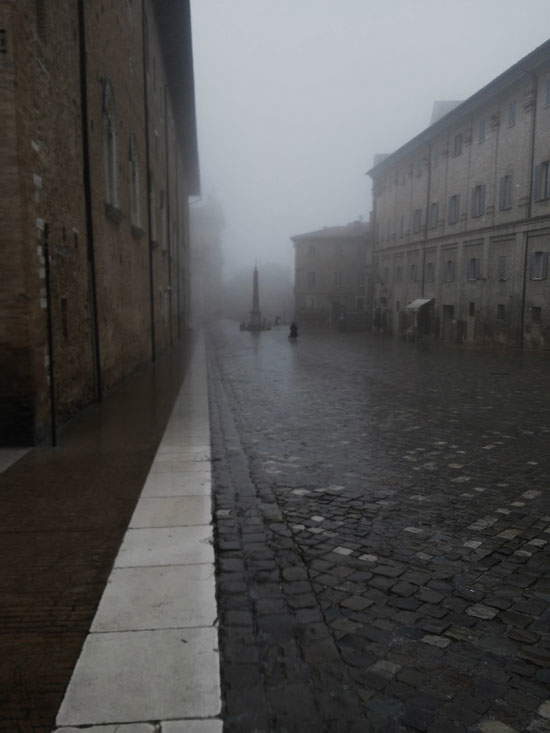 |
| Urbino, Piazza Rinascimento under the blizzard |
 |
| The courtyard of the Ducal Palace |
As we anticipated, the Palazzo houses the wonderful rooms of the Galleria Nazionale delle Marche, where works by numerous local and non-local artists follow one another, making the Galleria one of the most important museums in Italy. The Palace was the seat of the ancient Montefeltro seigniory, in particular of the very famous Federico, to whom famous artists dedicated portraits. One of these can be found right here: it is the one made by Pedro Berruguete, the Portrait of Federico with his son Guidobaldo, which during your visit to the Gallery you will find near Federico da Montefeltro’s Chapel and his famous Studiolo, where the Duke delighted in reading and studies. Indeed, in his intentions figured a Renaissance model where military virtue was accompanied by wisdom. A jaw-dropping marvel depicted in all art history manuals, but which in person conveys a great emotion, so great that one is enraptured in front of these walls lined with inlaid wood with carefully detailed representations and portraits of Illustrious Men who seem to look down upon it from above.
But this is not the only room that leaves the visitor bewitched by such beauty: there is in fact a room that houses two of Piero della Francesca’s most beautiful works: the Madonna of Senigallia and the Flagellation, the latter still of uncertain significance.
In front of these works, we stood in absolute silence admiring the fineness of the details, the reflections that could be glimpsed in the clothes and jewelry of the characters in the paintings, and trying to peer into the gazes of the characters almost as if to make them tell us the stories they conceal and remind us of the meaning of the paintings. Everything contributes to the fascination of this room: in the half-light of the entire room, the two works illuminated by a warm and enveloping light stand out.
Another masterpiece to which an entire room is devoted is the famous Ideal City, the work in which perspective culminates at its highest level.
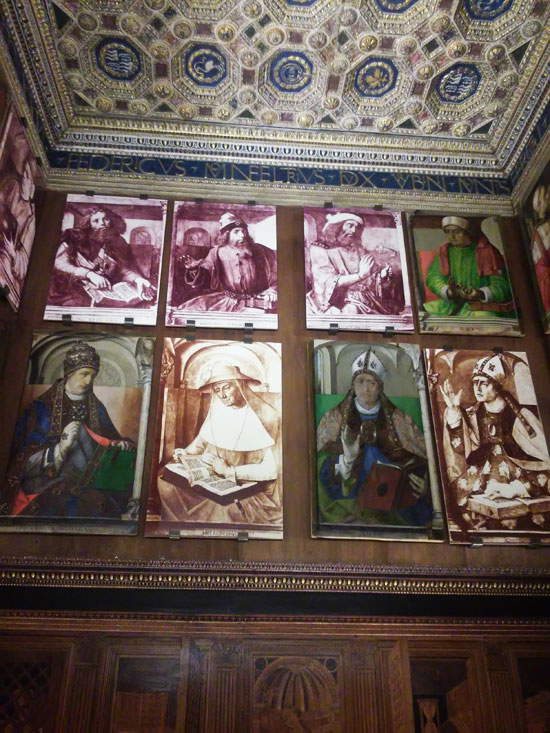 |
| Federico da Montefeltro’s studiolo. |
 |
| Ilaria contemplates Piero della Francesca’s Flagellation |
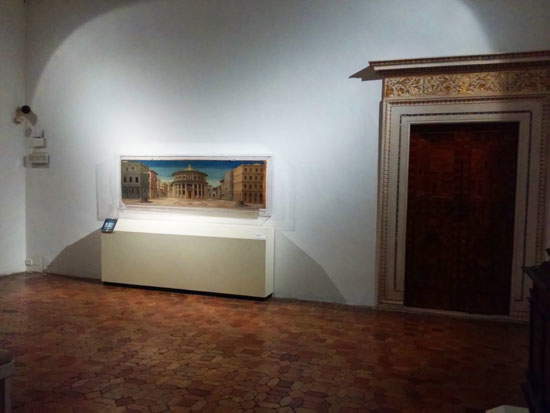 |
| The room with the Ideal City |
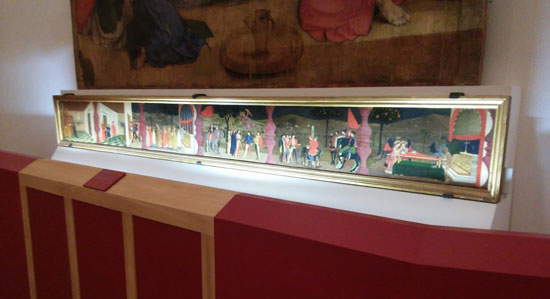 |
| Paolo Uccello’s predella |
A palace, then, that houses great masterpieces of art history, such as those just mentioned, as well as works by Paolo Uccello, such as the Profanation of the Host, by Titian, by Federico Barocci, by Luca Signorelli, by Giovanni Santi, father of Raphael, or by Raphael himself, who was born in Urbino, such as the Portrait of a Gentlewoman (The Mute), the latter unfortunately not present because it was transferred for an exhibition. A palace that recounts the daily life of one of the greatest seigniories of the Renaissance: during the visit we can realize the layout of the large and numerous rooms that were once inhabited by the Montefeltro family; we can even see the Duke’s alcove. And if you want to continue the discovery of the rooms of the Ducal Palace of Urbino, do not hesitate to walk through the undergrounds: you will find the kitchen, the bathroom, the wash-house, the neviera, the stables... a detail that we found at the entrance of the stables, but that we also noticed while walking around the city, is the continuous presence of strange, very steep stone stairs, perhaps to facilitate the walk for the horses.
As we told you, at the Ducal Palace we also had dinner! Where? In the Palace restaurant overlooking the Cortile d’Onore! Here you can taste the typical specialties of the city: we chose to try the crescia sfogliata, a kind of piadina that, as the name suggests, is flaky. You can enjoy it in the traditional version with vegetables and cheese or in the version with cold cuts and cheese. We recommend both! :)
Before we leave the city, however, it is a must to admire the splendid facade of the Ducal Palace with its characteristic little towers, which has become, it can be said, one of the symbols of Urbino.
It is with great regret that we leave this wonderful city with the promise that one day we will return for a better visit, because it really deserves it. Hoping this time for more clement weather.
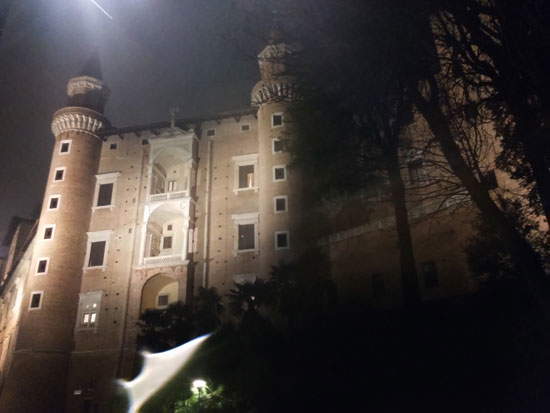 |
| The facade of the little towers of the Ducal Palace at night, in the rain |
Warning: the translation into English of the original Italian article was created using automatic tools. We undertake to review all articles, but we do not guarantee the total absence of inaccuracies in the translation due to the program. You can find the original by clicking on the ITA button. If you find any mistake,please contact us.